Organizational cultures that reinforce the intensification of work through digital resources and their impact on occupational health
Keywords:
digital work, organizational culture, labor intensification, Social isolation, psychosocial risks, organizations, psychosomatic pathologiesAbstract
The digitalization of the economy has had a double aspect in its application, on the one hand, it has been a dynamic element, but, on the other, it is influenced by organizational cultures that reinforce the intensification of work. In this context, the article studies from the prevention of occupational hazards (PRL) the impact of digital work on the emergence of psychosocial risks. For this purpose, through the theories of demand-control-social support of karasek, the microdata of the National Survey of Working Conditions of 2011 (nº=8,892) have been analyzed comparing the exposure to psychosocial risks among workers / as digital and non-digital, estimating the odds ratio (OR) and their 95% confidence intervals (95% CI) using raw binary logistic regressions (ORc) and adjusted (ORa) by sociodemographic variables, completing the study with a series of interviews conducted with PRL technicians. The results obtained show that the combined effect of greater labor intensification with a lower degree of control over work rhythms and a low social support of supervisors and colleagues derive in higher levels of techno-stress, techno-anxiety or cyberbullying (ORa=1.71; 95% CI 1.50-1.96) of digital workers over non-digital workers and, nevertheless, have a lower degree of protection (ORa=0.69; 95% CI 0.62- 0.77).
Downloads
References
Allvin, M. (2008). New rules of work: Exploring the boundaryless job. En K. Naswall, J. Hellgren, y M. Sverke (Eds.), The Individual in the Changing Working Life (pp. 19-45). Cambridge, Reino Unido: Cambridge University Press. doi: 10.1017/CBO9780511490064.002
Aloisi, A. (2016). Commoditized Workers. Case Study Research on Labour Law Issues Arising from a Set of ‘On-Demand/Gig Economy’ Platforms.. Comparative Labor Law & Policy Journal, 37(3), 620-653. doi: http://dx.doi.org/10.2139/ssrn.2637485
Álvarez-Cuesta, H. (2018). La gig economy y la obligación de coordinar la seguridad y salud de sus “autónomos”. Revista Jurídica de la Universidad de León, 5, 83-96. doi: http://dx.doi.org/10.18002/rjule.v0i5.5652
Arias-De la Torre, J., Molina, A.J., Férnandez-Villa, T., Artazcoz, L., y Martín, V. (2019). Mental health, family roles and employment status inside and outside the household in Spain. Gaceta Sanitaria, 33(3), 235-241.doi:
https://doi.org/10.1016/j.gaceta.2017.11.005
Ballester-Pastor, M.A. (2013). La política de la OIT de la Unión Europea sobre salud y riesgospsicosociales. Revista Internacional y Comparada de Relaciones Laborales y Derecho del Empleo, 1(4), 8-30.
Bassanini, A. y Caroli, E. (2014). Is Work Bad for Health? The Role of Constraint vs Choice. Bonn, Alemania: IZA (Institute of Labor Economics) Discussion Paper No. 7891. Recuperado de http://ftp.iza.org/dp7891.pdf
Brocal, F. (2016). Incertidumbres y retos ante los riesgos laborales nuevos y emergente. Archivos de prevención de riesgos laborales, 19(1), 6-9. Doi: 10.12961/aprl.2016.19.01.1
Brocal, F., y Sebastián, M.A. (2015). Analysis and Modeling of New and Emerging Occupational Risks in the Context of Advanced Manufacturing Processes. Procedia Engineering, 100, 1150-1169. Doi: https://doi.org/10.1016/j.proeng.2015.01.478
Brynjolfsson, E., y Mcafee, A. (2014). The Second Machine Age: Work, Progress, and Prosperity in a Time of Brilliant Technologies. Nueva York, EEUU: Norton & Company.
Brun, E., y Milczarek, M. (2007). Expert forecast on emerging psychosocial risks related to occupational safety and health. Luxemburgo: Office for Official Publications of the European Communities. Recuperado de https://osha.europa.eu/en/publications/report-expert-forecast-emerging-psychosocial-risks-related-occupational-safety-and
Castejón, E., y Crespán, X. (2007). Accidentes de trabajo: [casi] todos los porqués. Cuadernos de Relaciones Laborales, 25(1),13-57. Recuperado de https://revistas.ucm.es/index.php/CRLA/article/view/CRLA0707120013A
Castells, M. (2011). La Sociedad Red. La Era de la Información, Volumen 1. Madrid, España: Alianza Editorial
Cohidon, C., Niedhammer, I., Wild, P., Guéguen, A., Bonenfant, S., y Chouanière, D. (2014). Exposure to job-stress factors in a national survey in France. Scandinavian Journal of Work, Environment & Health, 30(5), 379-389. doi: 10.5271 / sjweh.826
Denison, D. (1996). What is the different between organizational culture and organizational climate? A Native’s Point Of View on a Decade of Paradigms Wars. Academy of management review, 21(3), 619-654. doi: https://doi.org/10.5465/amr.1996.9702100310
Degryse, C. (2016). Digitalisacion of the economies and its impact on labour markets. Bruselas, Belgica: European Trade Union Institute (ETUI) Working Paper. Recuperado de https://www.etui.org/Publications2/Working-Papers/Digitalisation-of-the-economy-and-its-impact-on-labour-markets
Di Tecco, C., Jain, A., Valenti, A., Iavicoli, S., y Leka, S. (2017). An evaluation of the impact of a policy-level intervention to address psychosocial risks on organisational action in Italy. Safety Science, 100, 103-109. doi: https://doi.org/10.1016/j.ssci.2017.05.015
De Stefano, V. (2016). The rise of the «justin-time workforce»: On-demand work, crowdwork and labour protection in the «gig-economy». Ginebra, Suiza: ILO, Conditions of Work and Employment Series, nº 71. Recuperado de https://www.ilo.org/wcmsp5/groups/public/---ed_protect/---protrav/---travail/documents/publication/wcms_443267.pdf
EU-OSHA. (2016). Second European Survey of Enterprises on New and Emerging Risks (ESENER-2) Overview Report: Managing Safety and Health at Work. Luxemburgo: Publications Office of the European Union. Recuperado de https://osha.europa.eu/es/european-survey-enterprises-new-and-emerging-risks-esener
EU-OSHA. (2018). Foresight on new and emerging occupational safety and health risks associated with digitalisation by 2025. Luxemburgo: Publications Office of the European Union. Recuperado de https://osha.europa.eu/en/publications/foresight-new-and-emerging-occupational-safety-and-health-risks-associated
EU-OSHA. (2019). Third European Survey of Enterprises on New and Emerging Risks (ESENER 3). Bilbao, España: European Agency for Safety and Health at Work (EU-OSHA). Recuperado de https://osha.europa.eu/en/publications/third-european-survey-enterprises-new-and-emerging-risks-esener-3/view
Eurofound (2016). Sixth European Working Conditions Survey – Overview report. Luxemburgo: Publications Office of the European Union. Recuperado dehttps://digitalcommons.ilr.cornell.edu/cgi/viewcontent.cgi?referer=https://www.google.com/&httpsredir=1&article=1605&context=intl
Felstead, A., y Green, F. (2017). Working longer and harder? A critical assessment of work effort in Britain in comparison to Europe. En D. Grimshaw, C. Fagan, G. Hebson, y I. Tavora, (Eds.), Making Work More Equal: A New Labour Market Segmentation Approach (pp.188-207). Manchester, Reino Unido: Manchester University Press. doi: 10.7765 / 9781526125972.00018
Fernández-Avilés, J.A., Fernandez-Martinez, S., Mella-Mendez, L., Rodriguez-Rico, V., y Todolí-Signes, A. (2018). El trabajo en la economía colaborativa y la prevención de riesgos laborales. Madrid, España: Secretaria de Salud Laboral y Medio Ambiente de UGT-CEC. Recuperado de https://www.ugt.es/sites/default/files/03_guia_estudio_0.pdf
Ford, M. (2016). El auge de los robots: La tecnología y la amenaza de un futuro sin empleo. Barcelona, España: Ediciones Paidós.
Frey, C., y Osborne, M. (2013). The future of employment: how susceptible are jobs to computerisation?. Oxford, Reino Unido: University of Oxford.
Gilbert-Ouimet, M., Trudel, X., Brisson, C., Milot, A., y Vézina, M. (2014). Adverse effects of psychosocial work factors on blood pressure: systematic review of studies on demandcontrol-support and effort-reward imbalance models. Scandinavian Journal of Work, Environment & Health, 40, 109–132. doi: 10.5271 / sjweh.3390
Green, F. (2004). Why has work effort become more intense?. Industrial Relations: A Journal of Economy and Society, 43(4), 709-741. doi: https://doi.org/10.1111/j.0019-8676.2004.00359.x
Green, F. (2006). Demanding Work: The Paradox of Job Quality in the Affluent Economy. Princeton University Press. Princeton, EEUU: Recuperado de www.jstor.org/stable/j.ctt4cgbjg
George, D., y Mallery, P. (2013). SPSS/PC+step by step: a simple guide and reference. Belmont, EEUU: Wadsworth Publishing.
González-Ortega, S. (2005). El tratamiento de los riesgos del trabajo de los trabajadores autónomos. Temas laborales: revista andaluza de trabajo y bienestar social, 81, 149-172.
Hankivsky, O., y Christoffersen, A. (2008). Intersectionality and the determinants of health: a Canadian perspective. Critical Public Healt, 18(3),271-283, https://doi.org/10.1080/09581590802294296.
Hankivsky, O. (2012). Women's health, men's health, and gender and health: implications of intersectionality. Social Sciencia and medicine, 74(11), 1712-1720. DOI:10.1016/j.socscimed.2011.11.029.
Harris, S., y Krueger, A. (2015). A Proposal for Modernizing Labor Laws for Twenty-First Century Work: The “Independent Worker. Washington, EEUU: The Hamilton Project. Discussion Paper 2015-10. Recuperado de https://www.hamiltonproject.org/assets/files/modernizing_labor_laws_for_twenty_first_century_work_krueger_harris.pdf
Harvey, S.B., Modini, M., Joyce, S., Milligan-Saville, J.S., Tan, L., Mykletun, A., Bryant, R.A., Christensen, H., y Mitchell, P.B. (2017). Can work make you mentally ill? A systematic meta-review of work-related risk factors for common mental health problems. Occupational & Environtal Medicine, 74, 301–310. doi: http://dx.doi.org/10.1136/oemed-2016-104015ç
Huws, U. (2014). Labor in the Digital Global Economy. The Cibertariat Comes of Age. Nueva York, EEUU: Monthly Review Press.
INSHT (2012). VII Encuesta Nacional de Condiciones de Trabajo, 2011. Madrid, España: Instituto Nacional de Seguridad e Higiene en el Trabajo (INSHT). Recuperado de https://www.insst.es/documents/94886/96082/VII+Encuesta+Nacional+de+Condiciones+de+Trabajo%2C+2011/399f13f9-1b87-41de-bd7e-983776f8212a
INSHT (2015). La organización preventiva de las empresas en España: características distintivas frente a otros modelos europeos. Madrid, España: Instituto Nacional de Seguridad e Higiene en el Trabajo. Recuperado de https://prl.ceoe.es/la-organizacion-preventiva-de-las-empresas-en-espana-caracteristicas-distintivas-respecto-a-otros-modelos-europeos/
INSHT (2017). Encuesta Nacional de Condiciones de Trabajo. 2015 6ª EWCS – España. Madrid, España: Instituto Nacional de Seguridad e Higiene en el Trabajo (INSHT). Recuperado de https://www.insst.es/documents/94886/96082/Encuesta+Nacional+de+Condiciones+de+Trabajo+6%C2%AA+EWCS/abd69b73-23ed-4c7f-bf8f-6b46f1998b45
Kubicek B., Korunka C., Paškvan M., Prem R., y Gerdenitsch, C. (2014) Changing Working Conditions at the Onset of the Twenty-First Century: Facts from International Datasets. En C. Korunka, y P. Hoonakker (Eds.), The Impact of ICT on Quality of Working Life (pp. 25-41). Dordrecht, Holanda: Springer. doi: 10.1007/978-94-017-8854-0
Lazarsfeld, P.F. y Barton, A.H. (1951). Qualitative Measurement in the Social Sciences. En D. Lemer, y H.D. Lasswell (Eds.), The Policy Sciences. Recent Developments in Scops and Method (pp.231-250). Stanford: Stanford University Press.
Lee, J. y Lee, Y.K. (2016). Can working hour reduction save workers?. Labour Economics, 40, 25–36. doi: https://doi.org/10.1016/j.labeco.2016.02.004
Leka, S., Jain, A., Iavicoli, S., y Di Tecco, C. (2015a). An evaluation of the policy contexton psychosocial risks and mental health in the workplace in the EuropeanUnion: achievements, challenges and the future. BioMed Research International, 2015,1-18. Doi: https://doi.org/10.1155/2015/213089
Leka, S., Van Wassenhove, W., y Jain, A. (2015b). Is psychosocial risk prevention possible? Deconstructing common presumptions. Safety Science, 71, 61-67. Doi: https://doi.org/10.1016/j.ssci.2014.03.014
López-Rodríguez, J. (2019). La prevención de riesgos laborales en el trabajo a demanda vía aplicaciones digitales. Lan Harremanak, 41, 42-62. doi: https://doi.org/10.1387/lan-harremanak.20876
Manzano-Santamaría, N. (2018a). NTP 1.122: Las Tecnologías de la Información y la Comunicación (TIC) (I): nuevas formas de organización del trabajo. Madrid, España: Instituto Nacional de Seguridad, Salud y Bienestar en el Trabajo (INSSBT). Recuperado de https://www.insst.es/documents/94886/566858/ntp-1122w.pdf/baa93260-6840-4b9b-9abb-b6980b7f8f71
Manzano-Santamaría, N. (2018b). NTP 1.123: Las Tecnologías de la Información y la Comunicación (TIC) (II): factores de riesgo psicosocial asociados a las nuevas formas de organización del trabajo. Madrid, España: Instituto Nacional de Seguridad, Salud y Bienestar en el Trabajo (INSSBT). Recuperado de https://www.insst.es/documents/94886/566858/ntp-1123.pdf/acb83bc7-e6d5-4ffa-ab7c-f05e68079ffb
Martin, J. (2002). Organizational Culture, Mapping the Terrain. Thousand Oaks, EEUU: Sage Publication.
Mazmanian, M., Orlikowski, W. J., y Yates, J. (2013). The autonomy paradox: The implications of mobile email devices for knowledge professionals. Organization Science, 24(5), 1337-1357. doi: https://doi.org/10.1287/orsc.1120.0806
Meil, P., y Kirov, V. (2017). Policy Implications of Virtual Work. Cham, Alemania: Palgrave MacMillan.
Middleton, C.A. (2007). Illusions of Balance and Control in an Always-on Environment: a Case Study of BlackBerry Users. Continuum: Journal of Media & Cultural Studies, 21(2), 165–178. doi: https://doi.org/10.1080/10304310701268695
Molina-Navarrete, C. (2019). Del acoso moral (mobbing) al ciberacoso en el trabajo (network mobbing): viejas y nuevas formas de violencia laboral como riesgo psicosocial en la reciente doctrina judicial. Revista de Trabajo y Seguridad Social. CEF, 437-438, 143-165
Olarte-Encabo, S. (2017). Prevención de riesgos profesionales en el trabajo autónomo. Balance de situación y retos pendientes. Revista General de Derecho del Trabajo y de la Seguridad Social, 47, 167-192. Recuperado de: https://www.iustel.com//v2/revistas/detalle_revista.asp?id_noticia=419506
O’Reilly, C., Chatman, J. y Caldwell, D. (1991). People and organizational culture: a profile comparison approach to assessing person-organization fit. Academy of management journal, 34 (3), 487-516. Doi: https://doi.org/10.5465/256404
Pardo-Albiach, J. (2010). Ciberacoso: cyberbullying, grooming, redes sociales y otros peligros≫. En J. Garcia Gonzalez (Coord.), Ciberacoso: la tutela penal de la intimidad, la integridad y la libertad sexual en Internet (pp. 51-85). Valencia, España: Tirant lo Blanch.
Payá, R., y Beneyto, P. (2019). Desigualdades de género en términos de condiciones de trabajo, empleo y salud laboral. Sociología y Tecnociencia, 9(2), 23-49. Doi: https://doi.org/10.24197/st.2.2019.23-49
Paškvan, M., y Kubicek, B. (2017). The intensification of work. En C. Korunka y B. Kubicek (Eds.), Job demands in a changing world of work (pp. 25-43). Springer International Publishing. Doi: https://doi.org/10.1007/978-3-319-54678-0_3
Pérez-Zapata, O., Alvarez-Hernandez, G., Castaño-Collado, C., y Lahera-Sánchez, A. (2015). Sostenibilidad y calidad del trabajo en riesgo: La intensificación del trabajo del conocimiento. Revista del Ministerio de Empleo y Seguridad Social, 116, 175-214. Recuperado de https://explotacion.mtin.gob.es/libreriavirtual/detalle.action?cod=W0141516
Perlow, L. A. (2012). Sleeping with your smartphone: How to break the 24/7 habit and change the way you work. Cambridge, EEUU: Harvard Business Review.
Pesole, A., Urzí-Brancati, M.C,. Fernández-Macías, E., Biagi, F., y González-Vázquez, I. (2018). Platform Workers in Europe Evidence from the COLLEEM
Survey. Luxemburgo: Publications Office of the European Union. Recuperado dehttps://publications.jrc.ec.europa.eu/repository/bitstream/JRC112157/jrc112157_pubsy_platform_workers_in_europe_science_for_policy.pdf
Rocha-Sánchez, F. (2017). Retos del Sindicalismo de clase ante la economía digital. Arxius de Sociologia, 36-37, 49-60. Recuperado de: http://roderic.uv.es/bitstream/handle/10550/66746/6431783.pdf?sequence=1&isAllowed=y
Rodríguez-Egio, M.M, (2018). Prevención de riesgos laborales en el ámbito de la economía colaborativa. En R. Alfonso-Sánchez y J. Valero Torrijos (Dirs.). Retos jurídicos de la economía colaborativa en el contexto digital. (pp. 499-522). Navarra, España: Thomson Reuters Aranzadi.
Rodriguez-Rico, V. (2018). Los retos para la prevención de riesgos laborales ante la tecnificación del trabajo. En N. Cerejeira-Namora, L. Mella-Mendez, D. Abrunhosa e Sousa, G. Cerejeira-Namora, y E. Castro Marques(Eds.), Health at work, ageing and environmental effects on future SocialSecurity and Labour Law Systems (pp. 71-93). Cambridge, Reino Unido: Cambridge Scholars Publishing.
Roquelaure, Y., Petit Lemanach A.C., Poisnel, C., Bodin, J., Descatha, A., y Imbernon, E. (2012). Working in temporary employment and exposure to musculoskeletal constraints. Occupational Medicine, 62(7), 514-518. doi: https://doi.org/10.1093/occmed/kqs004
Schein, E.H. (1983). The role of the founder in creating organizational culture. Organizational dynamics, 12 (1), 13-28. doi: https://doi.org/10.1016/0090-2616(83)90023-2
Srnicek, N. (2017). Platform Capitalism. Cambridge, Reino Unido: Polity Press.
Sundararajan, A. (2016). The Sharing Economy: The End of Employment and the Rise of Crowd-Based Capitalism. Cambridge, Reino Unido: MIT Press.
Tassinari, A., y Maccarrone, V. (2017). The mobilisation of gig economy couriers in Italy: some lessons for the trade union movement. Transfer: European Review of Labour and Research, 23(3), 353-357. doi: https://doi.org/10.1177/1024258917713846
Theorell, T., Hammarström, A., Aronsson, G., Träskman Bendz, L., Grape, T., Hogstedt, C., Marteinsdottir, I., Skoog, I., y Hall, C. (2015). A systematic review including metaanalysisof work environment and depressive symptoms. BMC Public Health, 15, 738. doi: DOI 10.1186/s12889-015-1954-4
Todolí-Signes, A. (2017). El trabajo en la era de la economía colaborativa. Valencia, España: Tirant Lo Blanch.
Todolí-Signes, A. (2019). Plataformas digitales y concepto de trabajador: una propuesta de interpretación finalista. Lan Harremanak, 41, 17-41. doi: https://doi.org/10.1387/lan-harremanak.20880
Utzet, M., Navarro, A., Llorens, C., y Moncada, S. (2015). Intensification and isolation:Psychosocial work environment changes in spain 2005–10. Occupational Medicine, 65(5),405-412. doi: https://doi.org/10.1093/occmed/kqv062
Valenduc, G., y Vendramin, P. (2017). Digitalisation, between disruption and evolution. Transfer: European Review of Labour and Research, 23(2), 121-134. doi: https://doi.org/10.1177/1024258917701379
Valsamis, D., De Coen, A., Vanoeteren, V., y Van Der Becken, W. (2015) Employment and Digital Skills. Aspects of the Digital Single Market Strategy. Bruselas, Bélgica: European Parliament. Recuperado de http://www.europarl.europa.eu/RegData/etudes/STUD/2015/569967/IPOL_STU(2015)569967_EN.pdf
Vega-Martínez, S. (2001). NTP 603: Riesgo psicosocial: el modelo demanda-control-apoyo social (I). Madrid, España: Instituto Nacional de Seguridad e Higiene en el Trabajo (INSHT). Recuperado de https://www.insst.es/documents/94886/326775/ntp_603.pdf/f15ca511-259c-480b-9f12-28ef5349b3c1
Velázquez-Fernández, M. P. (2019). El Convenio 190 de la OIT sobre violencia y acoso en el trabajo: principales novedades y expectativas. Revista de Trabajo y Seguridad Social. CEF, 437-438, 119-142.
Vogel L. (2015). The machinery of occupational safety and health policy in the European Union- History, institutions, actors. Bruselas, Belgica: European Trade Union Institute (ETUI). Recuperado de https://www.etui.org/Publications2/Guides/The-machinery-of-occupational-safety-and-health-policy-in-the-European-Union.-History-institutions-actors
Yagüe, S. (2020). Violencia y acoso en el trabajo: un análisis del nuevo concepto a la luz del 190º Convenio de la OIT. Revista Inclusiones (en prensa).
Downloads
Published
How to Cite
Issue
Section
License
Los derechos de edición pertenecen a la Fundación iS+D para la Investigación Social Avanzada, entidad que edita la Revista Prisma Social, y es necesario su permiso para cualquier reproducción. En todo caso, será necesario citar la procedencia de cualquier reproducción total o parcial.
La publicación de artículos o reseñas en la Revista Prisma Social no da derecho a remuneración alguna.
Política de acceso abierto
La publicación de la Revista Prisma Social y su difusión se realiza de forma abierta a través de Internet.
La Revista Prisma Social ofrece acceso libre y abierto inmediato a su contenido de forma totalmente gratuita con el fin de hacer llegar la investigación científica a toda la sociedad y con el objetivo de crear una cultura reflexiva encaminada a la comprensión de los comportamientos sociales desde una perspectiva global.
Todos los contenidos digitales de la Revista Prisma Social son de acceso libre y gratuito y se publican bajo una licencia de Creative Commons:

está bajo una licencia de Creative Commons Reconocimiento-NoComercial-SinObraDerivada 3.0 España License.
Creado a partir de la obra en www.isdfundacion.org
Bajo esta licencia, está permitida la reproducción y difusión de los contenidos de la revista con fines educativos o de investigación, sin ánimo de lucro, siempre y cuando estos no se modifiquen, se cite la procedencia (Prisma Social, Revista de ciencias sociales), y la autoría.
Esta licencia a la que se acoge la Revista Prisma Social permite copiar, distribuir, exhibir los textos e imágenes de la revista, siempre que se cumplan las siguientes condiciones:
- Reconocimiento: Debe reconocerse y respetarse la autoría de la obra de la manera especificada por el autor y la entidad editora (Revista Prisma Social – Fundación iS+D).
- No comercial: No se puede utilizar esta obra para fines comerciales.
- No derivados: No se puede alterar, transformar o generar una obra derivada a partir de esta obra.
Se deberán establecer claramente los términos de esta licencia para cualquier uso o distribución de los documentos. Se podrá prescindir de cualquiera de estas condiciones si se obtiene el permiso expreso del autor/a.
Desde la Revista de Prisma Social se permite y se invita a los/as autores/as a ampliar la visibilidad, alcance e impacto de sus artículos publicados en la revista mediante la redifusión (auto-archivo) de los mismos en:
1. Sus espacios web personales (web, blog, redes sociales, foros científicos, etc.).
2. Archivos abiertos institucionales (archivos universitarios, Hispana, Europeana, etc.).
3. Redes sociales de naturaleza académica y científica (ResearchGate, Academia.edu, Getcited.org).
Se requiere que en dichas publicaciones se detallen todos los datos bibliográficos de la publicación.
Para más información, puede descargar y consultar las Condiciones de Publicación:

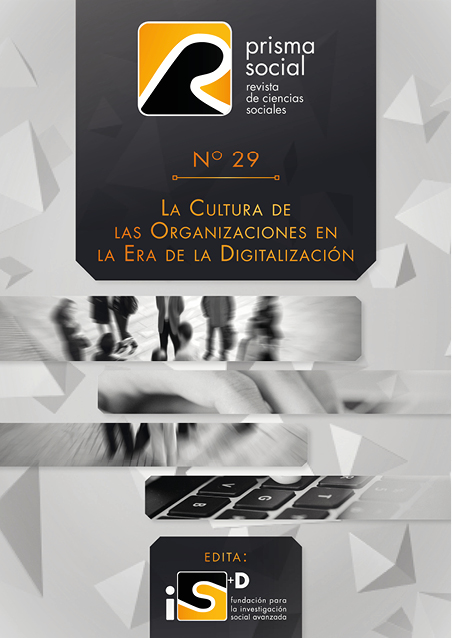




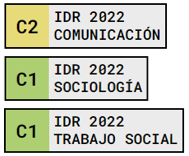

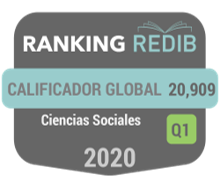
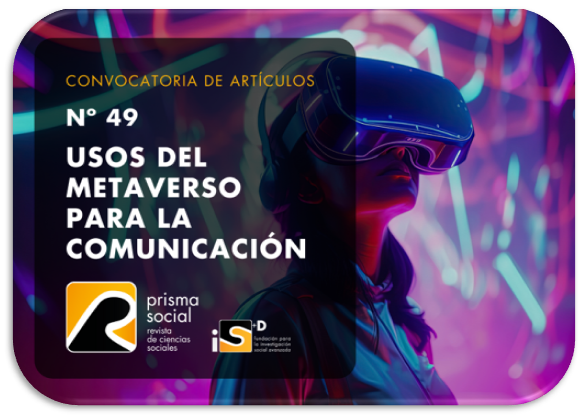
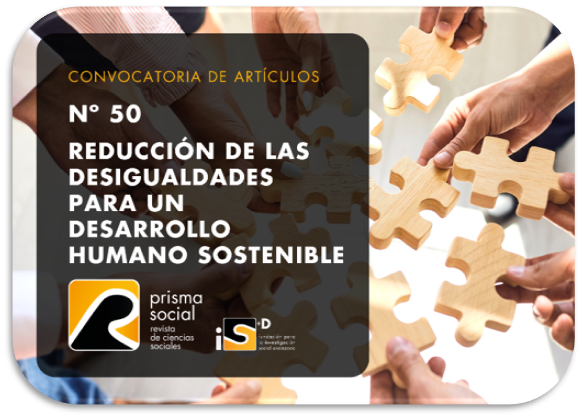








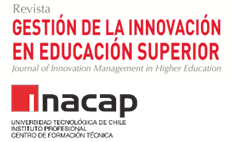



.png)




